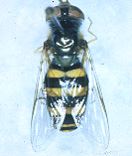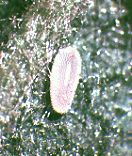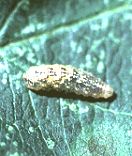
Syrphid Flies
Syrphid flies, also known as hover flies for their
ability
to hover in flight, are common predators of aphids and other soft
bodied
insects. Adults are usually bee mimics (picture at top ). Three of the
more common species are Syrphus rectus Osten Sacken (see egg
and
larva below), Allograpta obliqua (Say) and Eupeodes
(formerly
Metasyrphus)
americanus (Weidemann). A. obliqua may complete development
from egg to adult in less than 21 days. Various stages overwinter,
depending
on species, giving rise to adults in spring. Adults feed on pollen,
nectar
and aphid honeydew. Females must feed on pollen for proper egg
maturation.
Females oviposit in the midst of aphid colonies, using honeydew as an
ovipositional
stimulant, and laying hundreds of eggs each. Eggs are often the first
sign
of aphid predators seen in the spring (left picture below). Eggs are
white,
elliptical, and about 4/100 inch (1 mm) in length. There are three
larval
instars. Larvae are elongate, tapering gradually toward the head end
(right
picture below). Larvae search for prey by casting the forward end from
side to side; prey must be contacted directly to be detected. Larvae
pierce
aphids with their mouth hooks, sucking fluids from the bodies before
moving
to other prey. Each larva may consume hundreds of aphids during its
development.
Larval feeding success influences future fecundity. Third instar larvae
have the greatest impact on aphid numbers. Larvae of some species are
relatively
plump. There may be 5-7 generations per year. Multivoltine species
overwinter
as adults, univoltine species as third instar larvae. These are among
the
most voracious of aphid predators.
Additional information was developed by Brent
Short
and Chris Bergh on syrphids
in
apple
orchards in northern Virginia, as a part of "Arthropod
Management
in Fruit Crops", ENT


from a chapter in the Mid-Atlantic Orchard
Mnitoring
Guide, entitled Aphid Predators,
by D. G. Pfeiffer
and H. W. Hogmire
E-mail to: Douglas G. Pfeiffer


